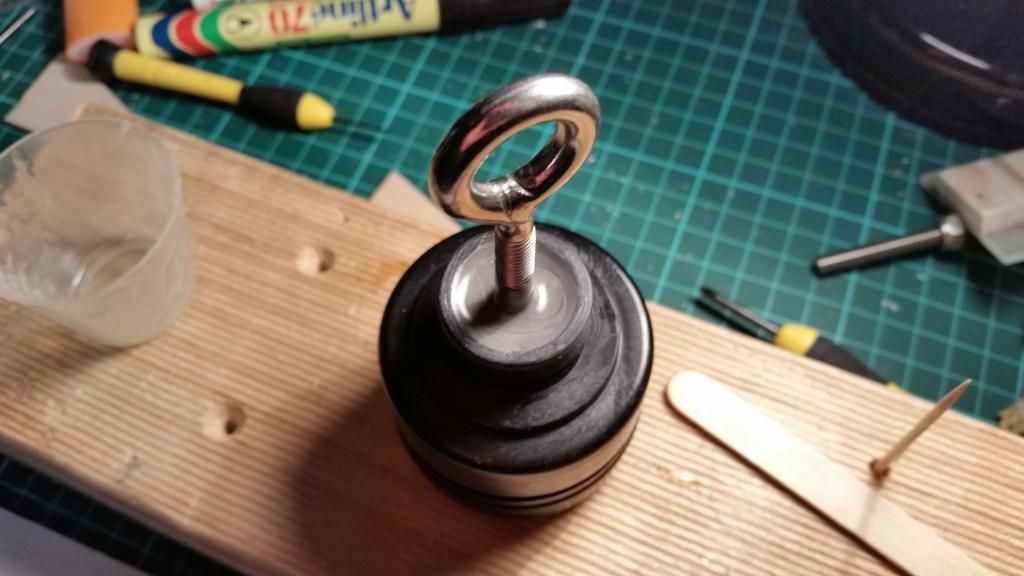First of all, I am really sorry that they didn't separate. I would like to try to find out why. And of course if you PM me your address I will be happy to replace the guides with a new set incorporating all the latest improvements.
Thanks a bunch for the offer, Bill. I was thinking of ordering two this time around just to have a backup, I wasn't expecting any offer of replacement, and I'm tempted to decline as much as I hate to say no to any free offer.

I'm fine with just ordering two from AMW, but I will answer your questions for any help it might provide.
Anyway, a few questions:
1. Do you happen to remember when you purchased the flyaway rail guides?
I purchased them from AMW on 4/30.
2. Were they translucent or opaque in color?
3. Did they have rail buttons or slides?
Opaque (bright orange as it was the thin-wall model, P38T), 3 white rail buttons.
4. Did they have one hinge or two?
There's a hinge at each end, I guess that means two?
5. Did you put the rubber band on the guides, flex them a couple of times, and then put them on the rocket, or did the rubber band go on after the rocket was on the rail? The important question here is whether the guides had a chance to flex open and closed a couple of times before the flight (this ensures that the rubber band is tensioned properly) ?
A little from both columns.

I had totally forgotten about the rubber band the first time I put the rocket on the rail. Thankfully I realized this before it was too late (just before I loaded the ignitor, though my altimeter was armed at that point), so I put the band on while it was on the rocket/rail, then removed the rocket from the rail, ensured that it opened and put it back on. So it didn't get flexed multiple times, only once, and likely not all the way open (I ensured that it started to open, but I was holding the rocket with one hand and the guide with the other at that point, so I'm pretty sure I didn't let it open all the way).
6. Are there any other unusual elements in this flight? Anything at all?
I don't think so. I do have a ground video I'd be happy to send you if you wish, as I look more closely the guide might have shifted downwards a bit as/after it left the rail, this rocket is MD with pretty small fillets (curvature of a plastic spoon tip) so I don't know what it might have hung-up on. Initially the guide had a bit of a loose fit, before I took it to my first flight (XPRS a month ago) I had added small strips of duct-tape on the inside to narrow the ID of the plastic a bit as it was too loose on the rocket. When I got to the rail at XPRS this made it too tight of a fit on their rail, so I removed about half of the tape (I think the issue was more the large head of the screw at the end of the rail buttons, I definitely prefer the buttons with the countersunk screw,
like this). I did not re-check the this launch here as I was a bit rushed at the pad, I can't say for certain that the tape hadn't maybe slid a bit and become sticky towards the rocket tube). I hadn't touched it since two successful flights at XPRS, but that was a month earlier (it went back into the bag in-between).
I will also state that I technically broke this guide the day I got it, but I was able to repair it. I totally didn't see that the two ends separated by
sliding them, and assumed they simply snapped onto each other, but when I pulled them apart at what seemed to be the optimal angle for separation one of the two outer hinges broke. But it broke pretty cleanly along the axis it was printed, and with some CA I was able to re-attach the broken piece solidly, this was before my first two flights at XPRS so it obviously survived those and hinged freely. Or maybe the pieces came separate and I broke the hinge by snapping the two pieces together the first time, i forget.
Any information you can provide would be helpful, and again please send me your address so I can dispatch a new set post-haste (and let me know if you prefer thin wall or thick-wall guides).
Thanks, I hope I can find a way to make it right.
You already have just by showing interest in this thread. I was not trying to speak anything bad about this product, it's a fantastic idea and a great implementation and it could very well be something I did poorly by being rushed (never a good idea of course), more that it might be a good idea for people to put their name/contact on the guide just in case it doesn't land close enough to find and someone else finds it later (bright colors certainly are a good idea). If there's any other comment I have about the product it's that explaining how it is meant to separate/connect would be a good idea (or else I totally missed it), and I'd much prefer to see countersunk rail guide screws vs. large pan-heads. In fact I was thinking about seeing whether I could change this myself on mine since I have some extra rail buttons (but I'm not sure if the screw size is the same as what the guide expects).





